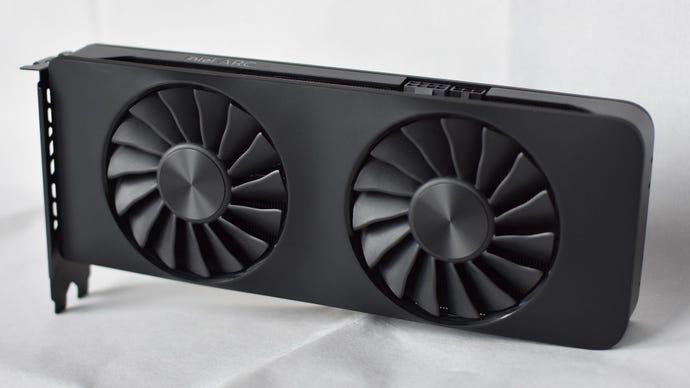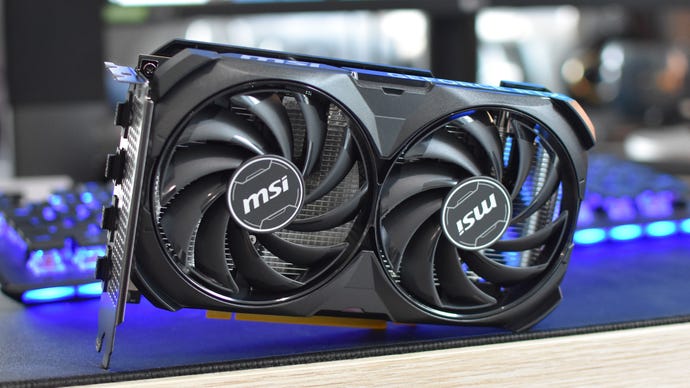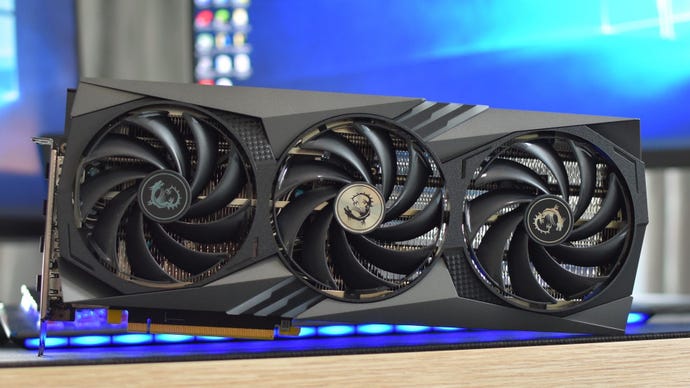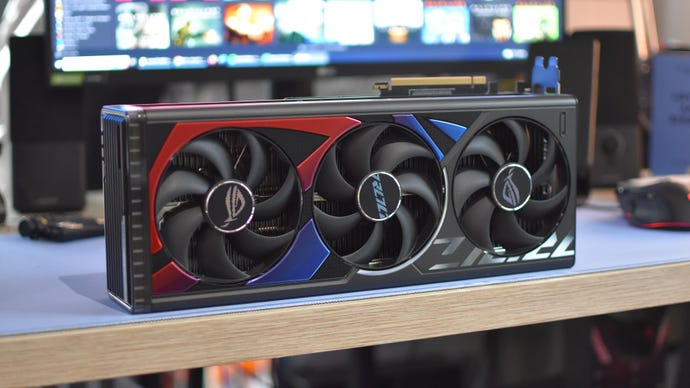Best graphics cards: the top gaming GPUs
Our top graphics card picks for 1080p, 1440p, and 4K
Figuring out the best graphics cards used to be a matter of lining them all up on a benchmark bar chart and seeing which had the biggest number next to them. You can still boil down your GPU upgrade choices to this simple act of almost-maths, but between ray tracing, DLSS and FSR upscaling, frame generation, and other types of algorithm-aided rendering machinations, you’re really best off considering all the variables. Or, at least, letting us consider them for you, with this handy list of ideal graphics cards for different resolutions.
They’ve all made the cut by impressing in our GPU testing regimen, which not only covers a wide selection of games and monitor rezzes but also all those extra features that a modern card should support. Ray tracing? Tested. Upscaling? Tested. Frame gen? Tested, though I’ll say right now that DLSS 3-compatible GPUs have the advantage here. Or, rather, DLSS 3 has the advantage over FSR 3, which is supported in far fewer games and doesn’t look quite as sharp in motion.
Either way, this guide will never recommend a graphics card that hasn’t had a proper up-close assessment, so all you need to do is pick one that’s a good fit for your resolution. Naturally, that means getting enough power on tap to adequately fill all those pixels, and high performance at 1440p or 4K will take a lot more oomph than 1080p. Still, don’t feel you have to reach for the GPU stars, as there are multiple budget-friendly and mid-range models that will comfortably turn out the frames at lower resolutions.
It's also good practice to think about how your new graphics card will gel with your PC’s other components. An adequate power supply is essential – most GPUs these days need a 550W PSU or higher – and be careful of pairing cutting-edge GPUs with older CPUs. Weaker processors can act as a bottleneck on graphics performance, especially at lower resolutions, where the GPU isn’t straining as much itself. That’s not to say you should always upgrade your CPU with every new graphics card purchase, but if your new GPU doesn’t seem as fast as it should be, a bottlenecking CPU may be the culprit.
Enough worrywarting, though. Nothing can make a gaming PC better at games than a new graphics card, so how's about we look at some great ones?
The best graphics cards for gaming
- Intel Arc A750 Limited Edition - the best cheap 1080p graphics card
- Nvidia GeForce RTX 4060 - the best 1080p graphics card
- Nvidia GeForce RTX 4060 Ti - the best 1440p graphics card
- Nvidia RTX 4070 Super - the best graphics card for ultrawide gaming monitors
- Nvidia GeForce RTX 4080 Super - the best graphics card for 4K
Intel Arc A750 Limited Edition
The best cheap 1080p graphics card

The Intel Arc A750 Limited Edition began life as a middle-whelming GPU, even by budget standards. Fortunately, Intel have pumped so many driver updates into this thing that it now performs significantly better, to the point of overwhelming the RTX 3050 in most of our 1080p gaming benchmarks. If there was a ‘Most Improved’ category in this list, the Arc A750 would win that as well.
In opting for this over the RTX 3050, you do miss out on DLSS support, owing to Nvidia’s upscaler being exclusive to Nvidia graphics cards. But upscaling isn’t as useful at 1080p as it is at higher, more demanding monitor resolutions, and even if you’re intent on using it when available, the Arc A750 has dual support for Intel XeSS and AMD FSR: two respectable alternatives.
The only real catch, then, is that getting the best performance out of the Arc A750 requires manually enabling Resizeable BAR (or Smart Access Memory on AMD motherboards). With any luck, your mobo might include this as a quick toggle in the BIOS' EZ mode. Just make sure it’s switched on before you start playing.
Read more in our Intel Arc A750 Limited Edition review
Nvidia GeForce RTX 4060
The best 1080p graphics card

The Nvidia GeForce RTX 4060 kicked a nasty habit that the RTX 40 series had at the time: while the premium models suffered self-inflicted price gouging compared to their RTX 30 series equivalents, the RTX 4060 is no more costly than the RTX 3060 was at launch. Even so, it upgrades core performance, improves ray tracing, and adds the option of DLSS 3 frame generation in supporting games, cementing itself as a worthy successor for good times at 1080p.
Upscaling isn’t as helpful at this rez as it is at 1440p or 4K, as the starting render resolution is so low that you can clearly see how the results don’t match native sharpness. However, DLSS 3 usually lets you enable frame generation without the Super Resolution upscaling component, producing a framerate boost with no sharpness loss. This flexibility simply isn’t matched by AMD’s 1080p candidate, the RX 7600, giving the RTX 4060 an advantage despite these two GPUs otherwise scoring quite evenly in game benchmarks.
The non-ray-traced ones, anyway. The RTX 4060 is plainly better when those enhanced effects kick in, and if you’re likely to upgrade to a 1440p monitor, the Nvidia GPU is generally faster at that resolution too.
Read more in our Nvidia GeForce RTX 4060 review
Nvidia GeForce RTX 4060 Ti
The best 1440p graphics card

For a Quad HD-tuned PC, there’s a tough call to make between the AMD Radeon RX 7700 XT and this, the 8GB version of the Nvidia GeForce RTX 4060 Ti. The Radeon is faster in non-ray-traced, native rez games, and offers more VRAM, packing 12GB.
I’d still go for the RTX 4060 Ti, however. Besides being significantly cheaper than the RX 7700 XT – some models of which cost almost as much as an RX 7800 XT – it overturns its performance disadvantage once you start making use of all its toys. DLSS upscaling looks nicer than FSR’s, but there’s also the RTX 4060 Ti’s drastically superior ray tracing performance, and the possibility of enabling DLSS 3 to send framerates soaring.
Even standard DLSS upscaling can be enough to spin things in the RTX 4060 Ti’s favour. In Cyberpunk 2077, it could average 46fps at 1440p with maxed settings, Psycho ray tracing, and DLSS on Quality; the RX 7700 XT could only manage 38fps using Quality FSR.
Read more in our Nvidia GeForce RTX 4060 Ti review
Nvidia RTX 4070 Super
The best graphics card for ultrawide gaming monitors

The Nvidia GeForce RTX 4070 Super is a surprisingly potent upgrade on the original RTX 4070, gaining a marked performance uplift (especially at higher resolutions) without raising the price. You could even use it for some decent 4K, but it’s excellent for ultrawide resolutions as well. With ray tracing or upscaling, it’s either level with or slightly faster than the AMD Radeon RX 7800 XT on speed, and beats it outright whenever RT effects or DLSS upscaling are in play.
That alone is enough to take the 7800 XT’s spot in this list, but the RTX 4070 Super also supports DLSS 3, which enjoys compatibility with a much wider selection of games than AMD’s FSR 3. And even if it didn’t, FSR 3 works on Nvidia cards anyway, so the RTX 4070 Super loses out on nothing.
Read more in our Nvidia GeForce RTX 4070 Super review
Nvidia GeForce RTX 4080 Super
The best graphics card for 4K

Maybe a slightly contentious pick here – my Nvidia GeForce RTX 4080 Super review wasn’t especially glowing. But that was mainly down to its lack of a clear performance upgrade over the RTX 4080, in contrast to the RTX 4070 Super’s improved FPS-slinging.
It’s true that I wish the RTX 4080 Super took a bigger leap forward, but it does beat the RTX 4080 on price, despite being the newer, quicker version. That’s a big deal, as the biggest issue with the previous GPU was its unreasonable outlay. 4K performance was never a problem in itself, and the RTX 4080 Super maintains that ability to run max-quality, optionally ray-traced games at a fast clip. Factor in the lower cost, and its status as the best graphics card for 4K is the result of a simple numbers game.
(There’s also the RTX 4090, of course, but I don’t recommend that unless you’re a shipping magnate or are no more than fifth in line to a throne.)
Read more in our Nvidia GeForce RTX 4080 Super review
Frequently asked questions
Why are some graphics cards so expensive?If you've tried to buy a new graphics card since about September 2020, you'll know how hard it can be to get hold of one, and how nigh-impossible it is to do so at a truly low price. Only recently has the market been correcting course, though high RRPs have all too often replaced the previous issue of massive markups by third-party sellers.
The good news is that graphics cards are no longer as useful to large-scale cryptocurrency mining operations as they once were, so without the demand of miners looking to make a quick, environmentally devasting buck, prices and stock availability have (mostly) lowered and risen respectively.
Which graphics cards have ray tracing?Ray tracing can be a huge upgrade to how your games handle lighting, shadows and reflections, but you need compatible GPU to take advantage of it. Right now, that includes all of Nvidia's RTX 20 series, 30 series, and 40 series GPUs, and AMD's Radeon RX 6000 and RX 7000 cards. On the Nvidia side, that includes everything from the RTX 2060 up to the goliath RTX 4090, while AMD's ray tracing GPU range starts at the RX 6400 and ends at the RX 7900 XTX.
Intel have also released their first Arc graphics cards, bringing with them ray tracing support and Intel XeSS: an upscaling system similar to DLSS and FSR.
Which is better, AMD or Nvidia?An age old question, the answer to which seems to change with every generation of new GPUs. Right now, Nvidia have a wider range of compelling options across all resolutions, especially now they've started releasing more affordable RTX 40-series models. These GPUs don't always best their closest AMD equivalents on game performance, but they do have a clear advantage whenever ray tracing is involved, and can further improve their frame-per-second counts in a limited range of games using DLSS 3.
AMD graphics cards, however, are sometimes much easier on the wallet than their more cutting-edge competitors. And you may not care about ray tracing, in which case, a Radeon GPU may indeed be better for performance - we've seen this be the case with the Radeon RX 7800 XT versus the RTX 4070.
AMD and Nvidia are also narrowing on features. DLSS produces consistently better-quality upscaling than FSR, but newer versions like AMD FSR 2.0 (also known simply as FSR 2) have made the difference harder to notice. FSR 3 also grants frame interpolation capability to Radeon models, though the range of supporting games is even narrower than DLSS 3's.
That said, FSR itself isn’t a reason to buy a Radeon card specifically, as it's designed to work on all modern GPUs - Nvidia's included. DLSS specifically needs an RTX card, so if you want the best upscaling, there’s a much stronger reason to choose Nvidia.








